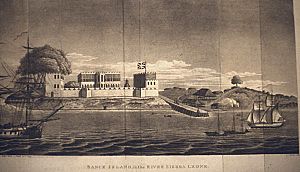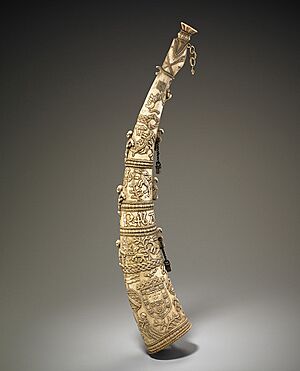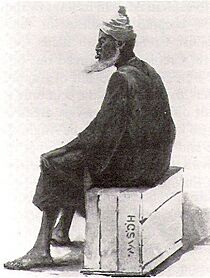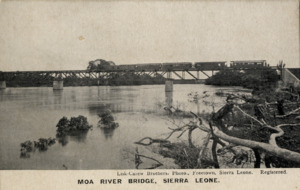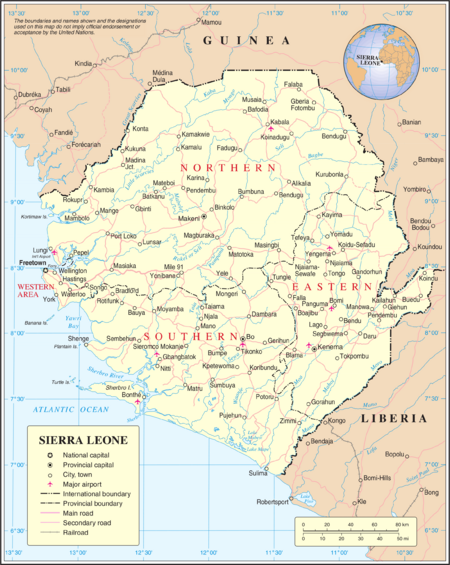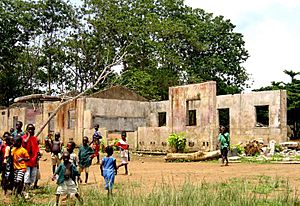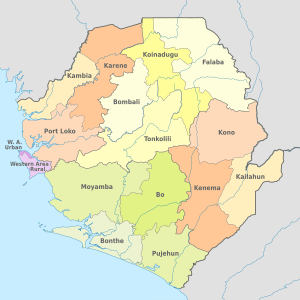Sierra Leone facts for kids
Quick facts for kids
Republic of Sierra Leone
Ripɔblik fɔ Siera Liɔn (Krio)
|
|
|---|---|
|
|
|
|
Motto: "Unity, Freedom, Justice"
|
|
|
Anthem: "High We Exalt Thee, Realm of the Free"
|
|
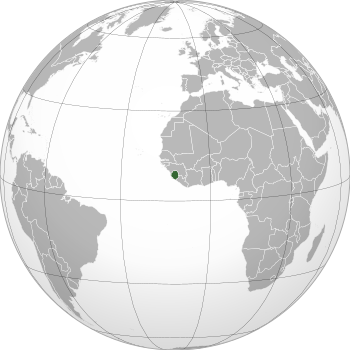
Location of Sierra Leone (dark green)
|
|
| Capital and largest city
|
Freetown 08°30′00″N 12°06′00″W / 8.50000°N 12.10000°W |
| Official languages | English |
| Recognised national languages | Krio |
| Ethnic groups
(2015)
|
|
| Religion
(2020)
|
|
| Demonym(s) | Sierra Leonean |
| Government | Unitary presidential republic |
| Julius Maada Bio | |
| Mohamed Juldeh Jalloh | |
|
• Chief Minister
|
David Sengeh |
| Legislature | Parliament |
| Independence
from the United Kingdom
|
|
|
• Dominion
|
27 April 1961 |
|
• Republic
|
19 April 1971 |
| Area | |
|
• Total
|
71,740 km2 (27,700 sq mi) (117th) |
|
• Water (%)
|
1.1 |
| Population | |
|
• 2023 estimate
|
8,908,040 (100th) |
|
• Density
|
124/km2 (321.2/sq mi) (114tha) |
| GDP (PPP) | 2024 estimate |
|
• Total
|
|
|
• Per capita
|
|
| GDP (nominal) | 2024 estimate |
|
• Total
|
|
|
• Per capita
|
|
| Gini (2024) | 33.7 medium |
| HDI (2024) | low · 184th |
| Currency | Leone (SLE) |
| Time zone | UTC (GMT) |
| Date format | dd/mm/yyyy |
| Driving side | right |
| Calling code | +232 |
| ISO 3166 code | SL |
| Internet TLD | .sl |
|
|
Sierra Leone is a country in West Africa. Its capital is Freetown. The official language is English.
The country was first made as a place where freed slaves could live. From 1991 until 2000, there was a civil war in Sierra Leone between rebels and the government. The war is now over. Sierra Leone is known for its blood diamonds. These were mined and sold during the civil war. This was in order to buy the weapons for the civil war.
There are 71,740 square kilometres of land in Sierra; In terms of land area it is similar in size to Ireland.
Sierra Leone has relied on mining, especially diamonds, for its economic base. The country is among the largest producers of titanium and bauxite, and a major producer of gold. The country has one of the world's largest deposits of rutile. Sierra Leone is also home to the third largest natural harbour in the world. Shipping from all over the globe goes to Freetown's famous Queen Elizabeth II Quay. Despite this natural wealth, 70% of its people live in poverty.
Sierra Leone is a mostly Muslim country.
The country has 2,090 known species of higher plants, 147 mammals, 626 birds, 67 reptiles, 35 amphibians, and 99 fish species.
Contents
- Etymology
- History
- Geography
- Government and politics
- Education
- Provinces and districts
- Tourism
- Food and customs
- Sports
- Related pages
- Images for kids
- See also
Etymology
Sierra Leone derives its name from the Lion Mountains near its capital, Freetown. Originally named Serra Leoa (Portuguese for 'lioness mountains') by Portuguese explorer Pedro de Sintra in 1462, the modern name is derived from the Venetian spelling, which was introduced by Venetian explorer Alvise Cadamosto and subsequently adopted by other European mapmakers.
History
Early history
Sierra Leone's history is marked by continuous human habitation for at least 2,500 years, influenced by migrations from across Africa. The adoption of iron technology by the 9th century and establishment of agriculture by 1000 AD along the coast. Climate shifts over centuries altered the ecological zones, influencing migration and conquest dynamics.
The region's dense tropical rainforest and swamps, coupled with the presence of the tsetse fly which carried a disease fatal to horses and the zebu cattle used by the Mandé people, provided natural defenses against invasions by the Mandinka Empire and other African empires, and limited influence by the Mali Empire, preserving its indigenous cultures from external dominions. The introduction of Islam by Susu traders, merchants and migrants in the 18th century further enriched the culture, eventually establishing a strong foothold in the north. The conquest by Samory Touré in the northeast solidified Islam among the Yalunka, Kuranko and Limba people.
European trading
The 15th century marked the beginning of European interaction with Sierra Leone, highlighted by Portuguese explorer Pedro de Sintra mapping the region in 1462 and naming it after the lioness mountains. This naming has been subject to historical reinterpretation, suggesting earlier European knowledge of the region. Following Sintra, European traders established fortified posts, engaging primarily in the slave trade, which shaped the socio-economic landscape significantly.
Traders from Europe, such as the Dutch Republic, England and France started to arrive in Sierra Leone and establish trading stations. These stations quickly began to primarily deal in slaves, who were brought to the coast by indigenous traders from interior areas, undergoing conflicts over territory. The Europeans made payments, called Cole, for rent, tribute, and trading rights, to the king of an area. Local Afro-European merchants often acted as middlemen, the Europeans advancing them goods to trade to indigenous merchants, most often for slaves and ivory.
Early Portuguese interactions
Portuguese traders were particularly drawn to the local craftsmanship in ivory, leading to a notable trade in ivory artifacts such as horns, Sapi Saltceller, and spoons. The Sapi people belonged to a cluster of people who spoke West Atlantic languages, living in the region of modern day Sierra Leone. There had already been a carving culture established in the area prior to Portuguese contact and many travelers to Sierra Leone initially impressed with their carving skills took local ivory horns back to Europe. One notable description at the beginning of the 16th century, by Pacheco noted that: in this country [Sierra Leone] they make beautiful mats of palm-leaf and necklaces of ivory [...]: In this land they make ivory necklaces more delicately carved than in any other country, also very fine and beautiful mats of palm-leaf, which are call 'bicas' [which are] very beautiful and good.
Black Poor of London
In the late 18th century, African Americans who had fought for the British Crown during the American Revolutionary War were resettled in Sierra Leone, forming a community named Black Loyalists. This resettlement scheme was partly motivated by social issues in London, with the Sierra Leone Resettlement Scheme offering a new beginning for the Black Poor, though it was fraught with challenges.
Resettlement of Black Loyalists
In the late 18th century, many African Americans claimed the protection of the British Crown. There were thousands of these Black Loyalists, people of African ancestry who joined the British military forces during the American Revolutionary War. Many had been slaves who had escaped to join the British, lured by promises of freedom (emancipation). Official documentation known as the Book of Negroes lists thousands of freed slaves whom the British evacuated from the nascent United States and resettled in colonies elsewhere in British North America.
Pro-slavery advocates accused the Black Poor of being responsible for a large proportion of crime in 18th century London. While the broader community included some women, the Black Poor seems to have exclusively consisted of men, some of whom developed relationships with local women and often married them. Slave owner Edward Long criticized marriage between black men and white women. However, on the voyage between Plymouth, England and Sierra Leone, 70 European girlfriends and wives accompanied the Black Poor settlers.
Many in London thought moving them to Sierra Leone would lift them out of poverty. The Sierra Leone Resettlement Scheme was proposed by entomologist Henry Smeathman and drew interest from humanitarians like Granville Sharp, who saw it as a means of showing the pro-slavery lobby that black people could contribute towards the running of the new colony. Government officials soon became involved in the scheme as well, although their interest was spurred by the possibility of resettling a large group of poor citizens elsewhere. William Pitt the Younger, prime minister and leader of the Tory party, had an active interest in the Scheme because he saw it as a means to repatriate the Black Poor to Africa, since "it was necessary they should be sent somewhere, and be no longer suffered to infest the streets of London".
Establishment of the Province of Freedom
In January 1787, the Atlantic and the Belisarius set sail for Sierra Leone, but bad weather forced them to divert to Plymouth, during which time about 50 passengers died. Another 24 were discharged, and 23 ran away. Eventually, with more recruitment, 411 passengers sailed to Sierra Leone in April 1787. On the voyage between Plymouth and Sierra Leone, 96 passengers died.
In 1787 the British Crown founded a settlement in Sierra Leone in what was called the "Province of Freedom". About 400 black and 60 white colonists reached Sierra Leone on 15 May 1787. After they established Granville Town, most of the first group of colonists died, owing to disease and warfare with the indigenous African peoples (Temne), who resisted their encroachment. When the ships left them in September, they had been reduced to "276 persons, namely 212 black men, 30 black women, 5 white men and 29 white women".
The settlers that remained forcibly captured land from a local African chieftain, but he retaliated, attacking the settlement, which was reduced to a mere 64 settlers comprising 39 black men, 19 black women, and six white women. Black settlers were captured by unscrupulous traders and sold as slaves, and the remaining colonists were forced to arm themselves for their own protection. The 64 remaining colonists established a second Granville Town.
Nova Scotians
Following the American Revolution, Black Loyalists from Nova Scotia, Canada, were relocated to Sierra Leone, founding Freetown and contributing significantly to the Krio people and Krio language that would come to define the region.
Following the American Revolution, more than 3,000 Black Loyalists had also been settled in Nova Scotia, where they were finally granted land. They founded Birchtown, but faced harsh winters and racial discrimination from nearby Shelburne. Thomas Peters pressed British authorities for relief and more aid; together with British abolitionist John Clarkson, the Sierra Leone Company was established to relocate Black Loyalists who wanted to take their chances in West Africa. In 1792 nearly 1,200 persons from Nova Scotia crossed the Atlantic to build the second (and only permanent) Colony of Sierra Leone and the settlement of Freetown on 11 March 1792. In Sierra Leone they were called the Nova Scotian Settlers, the Nova Scotians, or the Settlers. Clarkson initially banned the survivors of Granville Town from joining the new settlement, blaming them for the demise of Granville Town. The Settlers built Freetown in the styles they knew from their lives in the American South; they also continued American fashion and American manners. In addition, many continued to practise Methodism in Freetown.
In the 1790s, the Settlers, including adult women, voted for the first time in elections. In 1792, in a move that foreshadowed the women's suffrage movements in Britain, the heads of all households, of which a third were women, were given the right to vote. Black settlers in Sierra Leone enjoyed much more autonomy than their white equivalent in European countries. Black migrants elected different levels of political representatives, 'tithingmen', who represented each dozen settlers and 'hundreders' who represented larger amounts. This sort of representation was not available in Nova Scotia. The initial process of society-building in Freetown was a harsh struggle. The Crown did not supply enough basic supplies and provisions and the Settlers were continually threatened by illegal slave trading and the risk of re-enslavement.
Jamaican Maroons and Liberated Africans
The Sierra Leone Company, controlled by London investors, refused to allow the settlers to take freehold of the land. In 1799 some of the settlers revolted. The Crown subdued the revolt by bringing in forces of more than 500 Jamaican Maroons, whom they transported from Cudjoe's Town (Trelawny Town) via Nova Scotia in 1800. Led by Colonel Montague James, the Maroons helped the colonial forces to put down the revolt, and in the process the Jamaican Maroons in Sierra Leone secured the best houses and farms.
On 1 January 1808, Thomas Ludlam, the Governor of the Sierra Leone Company and a leading abolitionist, surrendered the company's charter. This ended its 16 years of running the Colony. The British Crown reorganised the Sierra Leone Company as the African Institution; it was directed to improve the local economy. Its members represented both British who hoped to inspire local entrepreneurs and those with interest in the Macauley & Babington Company, which held the (British) monopoly on Sierra Leone trade.
At about the same time (following the Slave Trade Act 1807 which abolished the slave trade), Royal Navy crews delivered thousands of formerly enslaved Africans to Freetown, after liberating them from illegal slave ships. These Liberated Africans or recaptives were sold for $20 a head as apprentices to the white settlers, Nova Scotian Settlers, and the Jamaican Maroons. Many Liberated Africans were treated poorly because some of the original settlers considered them their property. Cut off from their various homelands and traditions, the Liberated Africans were forced to assimilate to the Western styles of Settlers and Maroons. For example, some of the Liberated Africans were forced to change their name to a more Western sounding one. Though some people happily embraced these changes because they considered it as being part of the community, some were not happy with these changes and wanted to keep their own identity. Many Liberated Africans were so unhappy that they risked the possibility of being sold back into slavery by leaving Sierra Leone and going back to their original villages. The Liberated Africans eventually modified their customs to adopt those of the Nova Scotians, Maroons and Europeans, yet kept some of their ethnic traditions. As the Liberated Africans became successful traders and spread Christianity throughout West Africa, they intermarried with the Nova Scotians and Maroons, and the two groups eventually became a fusion of African and Western societies.
These Liberated Africans were from many areas of Africa, but principally the west coast. Between the 18th and 19th century, freed African Americans, some Americo Liberian "refugees", and particularly Afro-Caribbeans, mainly Jamaican Maroons, also immigrated and settled in Freetown. Together these peoples formed the Creole/Krio ethnicity and an English-based creole language (Krio), which is the lingua franca and de facto national language used among many of the ethnicities in the country.
Colonial era (1800–1961)
The colonial era saw Sierra Leone evolving under British rule, with a unique settlement pattern composed of displaced Africans following the abolition of the slave trade. Sierra Leone developed as an educational center in West Africa, with the establishment of Fourah Bay College in 1827, attracting English-speaking Africans from across the region.
The settlement of Sierra Leone in the 1800s was unique in that the population was composed of displaced Africans, brought to the colony after the British abolition of the slave trade in 1807. Upon arrival in Sierra Leone, each recaptive was given a registration number, and information on their physical qualities would be entered into the Register of Liberated Africans. Often documentation would be subjective and result in inaccurate entries, making them difficult to track. Differences between the Register of Liberated Africans of 1808 and the List of Captured Negroes of 1812 (which emulated the 1808 document) revealed disparities in the entries, specifically in the names; many recaptives decided to change their given names to anglicised versions which contributed to the difficulty in tracking them after they arrived.
In the early 19th century, Freetown served as the residence of the British colonial governor of the region, who also administered the Gold Coast (now Ghana) and the Gambia settlements. Sierra Leone developed as the educational centre of British West Africa. The British established Fourah Bay College in 1827, which became a magnet for English-speaking Africans on the West Coast. For more than a century, it was the only European-style university in west Sub-Saharan Africa. Samuel Ajayi Crowther was the first student to be enrolled. Fourah Bay College soon drew Creoles/Krio people and other Africans seeking higher education in British West Africa. These included Nigerians, Ghanaians, Ivorians and others, especially in the fields of theology and education. Freetown was known as the "Athens of Africa" due to the number of excellent schools in Freetown and surrounding areas.
The British interacted mostly with the Krio people in Freetown, who did most of the trading with the indigenous peoples of the interior. Educated Krio people held numerous positions in the colonial government, giving them status and well-paying positions. Following the Berlin Conference of 1884–85, the British decided they needed to establish more dominion over the inland areas, to satisfy what was described by the European powers as "effective occupation". In 1896 it annexed these areas, declaring them the Sierra Leone Protectorate. With this change, the British began to expand their administration in the region, recruiting British citizens to posts and pushing Krio people out of positions in government and even the desirable residential areas in Freetown.
During the British annexation in Sierra Leone, chiefs in the north and south of the country resisted the "hut tax" imposed by the colonial administrators. In the north, there was a Limba chief named Almamy Suluku fighting to protect his territory, while using diplomacy to trick the protectorate administrators, and sending fighters to assist Bai Bureh, a prominent Temne chief in Kasseh who was fighting against the "hut tax". The war was later known as the Hut Tax War of 1898.
Madam Yoko (c. 1849–1906) was a woman of culture and ambition. She employed her capacity for friendly communications to persuade the British to give her control of the Kpaa Mende chiefdom. She used diplomacy to communicate with local chiefs who did not trust her friendship with the British. Because Madam Yoko supported the British, some sub-chiefs rebelled, causing Yoko to take refuge in the police barracks. For her loyalty, she was awarded a silver medal by Queen Victoria. Until 1906, Madam Yoko ruled as a paramount chief in the new British Protectorate.
The British annexation of the Protectorate interfered with the sovereignty of indigenous chiefs. They designated chiefs as units of local government, rather than dealing with them individually as had been the previous practice. They did not maintain relationships even with longstanding allies, such as Bai Bureh, who was later unfairly portrayed as a prime instigator of the Hut Tax War.

Colonel Frederic Cardew, military governor of the Protectorate, in 1898 established a new tax on dwellings and demanded that the chiefs use their people to maintain roads. The taxes were often higher than the value of the dwellings, and 24 chiefs signed a petition to Cardew, stating how destructive this was; their people could not afford to take time off from their subsistence agriculture. They resisted payment of taxes, tensions over the new colonial requirements and the administration's suspicions towards the chiefs, led to the Hut Tax War. The British fired first; the northern front of mainly Temne people was led by Bai Bureh. The southern front, consisting mostly of Mende people, entered the conflict somewhat later, for other reasons.
For several months, Bureh's fighters had the advantage over the vastly more powerful British forces but both sides suffered hundreds of fatalities. Bureh surrendered on 11 November 1898 to end the destruction of his people's territory and dwellings. Although the British government recommended leniency, Cardew insisted on sending the chief and two allies into exile in the Gold Coast; his government executed 96 of the chief's warriors. Bureh was allowed to return in 1905, when he resumed his chieftaincy of Kasseh. The defeat of the Temne and Mende in the Hut Tax War ended mass resistance to the Protectorate and colonial government, but intermittent rioting and labour unrest continued throughout the colonial period. Riots in 1955 and 1956 involved "tens of thousands" of Sierra Leoneans in the Protectorate.
Domestic slavery, which continued to be practised by local African elites, was abolished in 1928. A notable event in 1935 was the granting of a monopoly on mineral mining to the Sierra Leone Selection Trust, run by De Beers. The monopoly was scheduled to last 98 years. Mining of diamonds in the east and other minerals expanded, drawing labourers there from other parts of the country.
In 1924, the UK government divided the administration of Sierra Leone into Colony and Protectorate, with different political systems for each. The Colony was Freetown and its coastal area; the Protectorate was defined as the hinterland areas dominated by local chiefs. Antagonism between the two entities escalated to a heated debate in 1947, when proposals were introduced to provide for a single political system for both the Colony and the Protectorate. Most proposals came from leaders of the Protectorate, whose population far outnumbered that in the colony. The Krios, led by Isaac Wallace-Johnson, opposed the proposals, as they would have resulted in reducing the political power of the Krios in the Colony.
In 1951, Lamina Sankoh (born:Etheldred Jones) collaborated with educated protectorate leaders from different groups, including Sir Milton Margai, Siaka Stevens, Mohamed Sanusi Mustapha, John Karefa-Smart, Kande Bureh, Sir Albert Margai, Amadu Wurie and Sir Banja Tejan-Sie joined together with the powerful paramount chiefs in the protectorate to form the Sierra Leone People's Party or SLPP as the party of the Protectorate. The SLPP leadership, led by Sir Milton Margai, negotiated with the British and the educated Krio-dominated colony based in Freetown to achieve independence. Owing to the astute politics of Milton Margai, the educated Protectorate elites were able to join forces with the paramount chiefs in the face of Krio intransigence. Later, Margai used the same skills to win over opposition leaders and moderate Krio elements to achieve independence from the UK.
In November 1951, Margai oversaw the drafting of a new constitution, which united the separate Colonial and Protectorate legislatures and provided a framework for decolonisation. In 1953, Sierra Leone was granted local ministerial powers and Margai was elected Chief Minister of Sierra Leone. The new constitution ensured Sierra Leone had a parliamentary system within the Commonwealth of Nations. In May 1957, Sierra Leone held its first parliamentary election. The SLPP, which was then the most popular political party in the colony of Sierra Leone as well as being supported by the powerful paramount chiefs in the provinces, won the most seats in Parliament and Margai was re-elected as Chief Minister by a landslide.
Independence and post-independence era
Sierra Leone was granted independence by the United Kingdom in 1961, transitioning to a state with its own governance structures, though it faced significant political instability post-independence, including the establishment of a one-party state and periods of civil unrest.
1960 Independence Conference
On 20 April 1960, Milton Margai led a 24-member Sierra Leonean delegation at constitutional conferences that were held with the Government of Queen Elizabeth II and British Colonial Secretary Iain Macleod in negotiations for independence held in London.
On the conclusion of talks in London on 4 May 1960, the United Kingdom agreed to grant Sierra Leone independence on 27 April 1961.
Independence 1961 - present
On 27 April 1961, Sir Milton Margai led Sierra Leone to independence from Great Britain and became the country's first prime minister. Sierra Leone had its own parliament and its own prime minister, and had the ability to make 100% of its own laws, however, as with countries such as Canada and Australia, Sierra Leone remained a "Dominion" and Queen Elizabeth was Queen of the independent Dominion of Sierra Leone. Thousands of Sierra Leoneans took to the streets in celebration. The Dominion of Sierra Leone retained a parliamentary system of government and was a member of the Commonwealth of Nations.
In May 1962, Sierra Leone held its first general election as an independent state.
In 1971, under Prime Minister Siaka Stevens of the All People's Congress (APC), the country adopted a new constitution, transforming Sierra Leone into a presidential republic, with Stevens as the inaugural president. In 1978, Stevens declared the APC to be the sole legally recognized party. In 1985, he was succeeded by Joseph Saidu Momoh. Momoh's enactment of a new constitution in 1991 reintroduced a multi-party system. That same year, a protracted civil war broke out between the government and the Revolutionary United Front (RUF) rebel group. The conflict, characterized by multiple coups d'état, persisted for 11 years. Intervention by ECOMOG forces and later by the United Kingdom resulted in the defeat of the RUF in 2002, ushering in a period of relative stability.
Geography
Sierra Leone is located on the southwest coast of West Africa, lying mostly between latitudes 7° and 10°N (a small area is south of 7°), and longitudes 10° and 14°W. The country is bordered by Guinea to the north and east, Liberia to the southeast, and the Atlantic Ocean to the west and southwest.
Sierra Leone has a total area of 71,740 km2 (27,699 sq mi), divided into a land area of 71,620 km2 (27,653 sq mi) and water of 120 km2 (46 sq mi). The country has four distinct geographical regions. In eastern Sierra Leone the plateau is interspersed with high mountains, where Mount Bintumani reaches 1,948 m (6,391 ft), the highest point in the country. The upper part of the drainage basin of the Moa River is located in the south of this region.
The centre of the country is a region of lowland plains, containing forests, bush and farmland, that occupies about 43% of Sierra Leone's land area. The northern section of this has been categorised by the World Wildlife Fund as part of the Guinean forest-savanna mosaic ecoregion, while the south is rain-forested plains and farmland.
In the west, Sierra Leone has some 400 km (249 mi) of Atlantic coastline, giving it both bountiful marine resources and attractive tourist potential. The coast has areas of low-lying Guinean mangroves swamp. The national capital Freetown sits on a coastal peninsula, situated next to the Sierra Leone Harbour.
The climate is tropical, with two seasons determining the agricultural cycle: the rainy season from May to November, and a dry season from December to May, which includes harmattan, when cool, dry winds blow in off the Sahara Desert and the night-time temperature can be as low as 16 °C (60.8 °F). The average temperature is 26 °C (78.8 °F) and varies from around 26 to 36 °C (78.8 to 96.8 °F) during the year.
Biodiversity
Sierra Leone is home to four terrestrial ecoregions: Guinean montane forests, Western Guinean lowland forests, Guinean forest-savanna mosaic, and Guinean mangroves.
Human activities claimed to be responsible or contributing to land degradation in Sierra Leone include unsustainable agricultural land use, poor soil and water management practices, deforestation, removal of natural vegetation, fuelwood consumption and to a lesser extent overgrazing and urbanization.
Deforestation, both for commercial timber and to make room for agriculture, is a major concern and represents an enormous loss of natural economic wealth for the country. Mining and slash and burn for land conversion – such as cattle grazing – dramatically diminished forested land in Sierra Leone since the 1980s. It is listed among countries of concern for emissions, as having Low Forest Cover with High Rates of Deforestation (LFHD). There are concerns that heavy logging continues in the Tama-Tonkoli Forest Reserve in the north. Loggers have extended their operations to Nimini, Kono District, Eastern Province; Jui, Western Rural District, Western Area; Loma Mountains National Park, Koinadougu, Northern Province; and with plans to start operations in the Kambui Forest reserve in the Kenema District, Eastern Province. The country had a 2019 Forest Landscape Integrity Index mean score of 2.76/10, ranking it 154th globally out of 172 countries.
Habitat degradation for the African wild dog, Lycaon pictus, has increased, such that this canid is deemed to have been extirpated in Sierra Leone.
Until 2002, Sierra Leone lacked a forest management system because of the civil war that caused tens of thousands of deaths. Deforestation rates have increased by 7.3% since the end of the civil war. On paper, 55 protected areas covered 4.5% of Sierra Leone as of 2003. This has led to a decline in the nations abundant natural wealth. The country has 2,090 known species of higher plants, 147 mammals, 626 birds, 67 reptiles, 35 amphibians, and 99 fish species. Unrestricted hunting during the war led to the decrease of many animal populations, including elephants, lions, and buffalo. Many of these animals can now only be found in sanctuaries. The tsetse fly is now dominant in the region and has led to an increase in the spread of the disease sleeping sickness. Still, Sierra Leone's bird populations have been largely the same and includes native birds such as cuckoos, owls, and vultures. The Tiwai Island Wildlife Sanctuary and the Gola Forest Reserves are just two examples of the humanitarian efforts to preserve wildlife after the civil war.
The Environmental Justice Foundation has documented how the number of illegal fishing vessels in Sierra Leone's waters has multiplied in recent years. The amount of illegal fishing has significantly depleted fish stocks, depriving local fishing communities of an important resource for survival. The situation is particularly serious as fishing provides the only source of income for many communities in a country still recovering from over a decade of civil war.
In June 2005, the Royal Society for the Protection of Birds (RSPB) and Bird Life International agreed to support a conservation-sustainable development project in the Gola Forest in south eastern Sierra Leone, an important surviving fragment of rainforest in Sierra Leone.
Government and politics
Sierra Leone is a constitutional republic with a directly elected president and a unicameral legislature. The current system of the Government of Sierra Leone is based on the 1991 Sierra Leone Constitution. Sierra Leone has a dominant unitary central government and a weak local government. The executive branch of the Government of Sierra Leone, headed by the president of Sierra Leone has extensive powers and influence. The president is the most powerful government official in Sierra Leone.
The president is the head of state, the head of government, and the commander-in-chief of the Sierra Leone Armed Forces. The president appoints and heads a cabinet of ministers, which must be approved by the Parliament. The president is elected by popular vote to a maximum of two five-year terms. The president is the highest and most influential position within the government of Sierra Leone.
To be elected president of Sierra Leone, a candidate must gain at least 55% of the vote. If no candidate gets 55%, there is a second-round runoff between the top two candidates.
Next to the president is the vice-president, who is the second highest-ranking government official in the executive branch of the Sierra Leone Government. As designated by the Sierra Leone Constitution, the vice-president is to become the new president of Sierra Leone upon the death, resignation, or removal of the President.
Parliament
The Parliament of Sierra Leone is unicameral, with 149 seats. Each of the country's 16 districts is represented in parliament. 135 members are elected concurrently with the presidential elections; the other 14 seats are filled by paramount chiefs from the country's administrative districts. The Sierra Leone parliament is led by the Speaker of Parliament, who is the overall leader of Parliament and is directly elected by sitting members of parliament. The current speaker of the Sierra Leone parliament is Abass Bundu, who was elected by members of parliament on 21 January 2014.
Judiciary
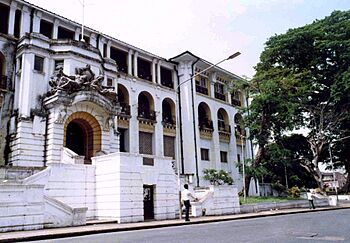
The judicial power of Sierra Leone is vested in the judiciary, headed by the Chief Justice of Sierra Leone and comprising the Supreme Court of Sierra Leone, which is the highest court in the country, meaning that its rulings, therefore, cannot be appealed against. Other courts are the High Court of Justice, the Court of Appeal, the magistrate courts, and traditional courts in rural villages led by a paramount chiefs and village elders that handle family and community dispute in civil cases. The president appoints and parliament approves Justices for the three courts. The Judiciary has jurisdiction in all civil and criminal matters throughout the country. The current acting chief justice of Sierra Leone is Desmond Babatunde Edwards. The Sierra Leone Judiciary is constitutionally independent from outside influences. However, in practice, the president of Sierra Leone has large unoficial power and influences over the Judiciary, including the influence to remove a sitting judge.
Education
Education in Sierra Leone is legally required for all children for six years. A shortage of schools and teachers has made this impossible. Two thirds of the adult population of the country are not able to read. The Sierra Leone Civil War caused the destruction of 1,270 primary schools. In 2001, 67% of all school-age children were out of school. This has been better since the end of the civil war.
The country has three universities: Fourah Bay College, University of Makeni and Njala University. Teacher training colleges and religious seminaries are found in many parts of the country.
Provinces and districts
The Republic of Sierra Leone has five regions the Northern Province, North West Province, Southern Province, the Eastern Province and the Western Area. The first four provinces are divided into 14 districts. The districts are further divided into 149 chiefdoms.
| District | Capital | Area km2 | Province | Population (2004 census) | Population (2008 estimates) |
|---|---|---|---|---|---|
| Bombali District | Makeni | 7,985 | Northern Province | 408,390 | 424,100 |
| Koinadugu District | Kabala | 12,121 | 265,758 | ||
| Port Loko District | Port Loko | 5,719 | 455,746 | 483,752 | |
| Tonkolili District | Magburaka | 7,003 | 347,197 | 370,425 | |
| Kambia District | Kambia | 3,108 | 270,462 | 299,725 | |
| Kenema District | Kenema | 6,053 | Eastern Province | 497,948 | 522,656 |
| Kono District | Koidu Town | 5,641 | 335,401 | ||
| Kailahun District | Kailahun | 3,859 | 358,190 | 389,253 | |
| Bo District | Bo | 5,473.6 | Southern Province | 463,668 | 527,131 |
| Bonthe District | Mattru Jong | 3,468 | 129,947 | 137,155 | |
| Pujehun District | Pujehun | 4,105 | 228,392 | 262,073 | |
| Moyamba District | Moyamba | 6,902 | 260,910 | ||
| Western Area Urban District | Freetown | 3,568 | Western Area | 1,272,873 | 1,473,873 |
| Western Area Rural District | Waterloo | 4,175 | 174,249 | 205,400 |
Largest cities
The largest cities in Sierra Leone are:
- Freetown 1,070,200
- Bo 269,000
- Kenema 158,496
- Koidu Town 111,800
- Makeni 105,900
Tourism
Sierra Leone's Freetown is a favourite destination for tourists. Although the sector was seriously affected during the Civil War, there has been a steady improvement in recent years. The city has a lot to offer to tourists. There is a vast expanse of beaches stretching along the Freetown Peninsula. The Lumley-Aberdeen beach stretches all the way from Cape Sierra Leone down to Lumley. There are also other popular beaches like the world renowned River Number 2 Beach, Laka Beach, Tokeh Beach, Bureh Beach, and Mama Beach. The Tacugama Chimpanzee Sanctuary, which is located within the peninsula's vast rainforest reserve, just a few kilometres from the centre of Freetown, has a collection of rare and endangered chimpanzees. Other popular destinations for tourists include the Freetown Cotton Tree, located in Central Freetown, a significant national monument and integral to the founding of the city; Bunce Island, which is a boat ride from the city, is home to the ruins of the slave fortress that was being used during the Transatlantic slave trade; the Sierra Leone Museum, which has a collection of both precolonial as well as colonial artifacts and other items of historical significance; the National Railway Museum; or take a journey around the city's coastline with the popular Sea Coach Express. The Aberdenn-Lumley area is a favourite destination for those venturing into the city's nightlife.
Food and customs
Rice is the staple food of Sierra Leone. It is eaten at nearly every meal daily. The rice is prepared in many ways, and topped with different sauces made from some of Sierra Leone's favorite toppings. These include potato leaves, cassava leaves, crain crain, okra soup, fried fish and groundnut stew.
Along the street of towns and cities one can find snacks such as fresh mangoes, oranges, pineapple, fried plantains, ginger beer, fried potato, fried cassava with pepper sauce; small bags of popcorn or peanuts, bread, roasted corn, or skewers of grilled meat or shrimp.
Poyo is a popular Sierra Leonean drink. It is a sweet, lightly fermented palm wine. Poyo bars are areas of lively informal talk about politics, football, entertainment and other issues.
Sports
Football is by far the most popular sport in Sierra Leone. Children, youth and adult are often seen playing street football across Sierra Leone.
The Sierra Leone national football team, popularly known as the Leone Stars, represents the country in international competitions. It has never qualified for the FIFA World Cup. They were in the 1994 and 1996 African Cup of Nations. Many of the national team footballers are celebrities across Sierra Leone. They are often well known by most of the country's general population. Some well known Sierra Leonean international footballers include Mohamed Kallon, Mohamed Bangura, Rodney Strasser, Ibrahim Teteh Bangura, Alhassan Bangura, Sheriff Suma, Mohamed Kamara, Umaru Bangura and Kei Kamara.
Related pages
Images for kids
-
A farmer with his rice harvest in Sierra Leone. Two-thirds of Sierra Leone's population are directly involved in subsistence agriculture.
-
Isata Mahoi shown editing radio programmes in Talking Drum studio Freetown; she is also an actress in the Sierra Leone radio soap opera Atunda Ayenda
-
National Stadium in Freetown.
-
Odelay mask by Temne people. Brooklyn Museum.
See also
 In Spanish: Sierra Leona para niños
In Spanish: Sierra Leona para niños





